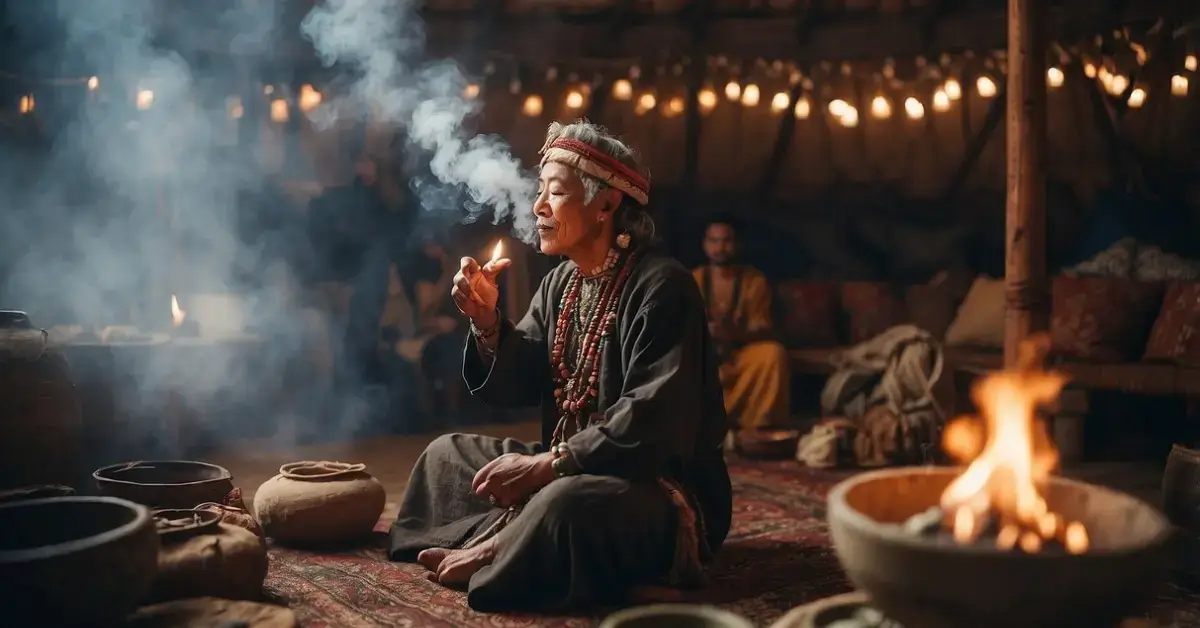Uncover the mystical world of Mongolian shamanism, exploring its unique practices, beliefs, and the role of shamans in connecting with the spiritual realm.
Origins and Beliefs of Mongolian Shamanism
Mongolian shamanism, an animistic and shamanic ethnic religion, has a deeply rooted history intertwined with Mongolia’s cultural and spiritual practices. It encompasses a rich tapestry of beliefs in spirits, ancestors, and natural elements.
History of Mongolian Shamanism
Mongolian shamanism has ancient origins, dating back to the earliest recorded history of the region. Archaeological findings and historical texts, such as the Mongolian Secret History, offer insights into its evolution. During the Yuan Dynasty, shamanism flourished, but it faced significant challenges and transformations during periods of political and social upheaval, including Soviet domination in the 20th century, which attempted to suppress traditional practices.
Core Concepts and Spiritual Hierarchy
Central to Mongolian shamanism are beliefs in spirits and ancestor worship. Shamans act as intermediaries between humans and the spiritual world, engaging in rituals to communicate with spirits and offer guidance. The spiritual hierarchy includes various types of spirits, from ancestral to nature spirits. The term Tengerism is also used, reflecting the reverence of the Eternal Blue Sky, a significant spiritual entity.
Influences from Buddhism and Other Beliefs
Mongolian shamanism has interacted and mingled with other religious practices, notably Tibetan Buddhism. The concept of Yellow Shamanism emerged, combining Buddhist elements with traditional shamanic practices. Despite the strong influence of Buddhism, shamanistic practices have persisted, forming a unique composite within Mongolian folk religion. This syncretism showcases the adaptability and resilience of Mongolian shamanism within the broader cultural and religious landscape.
Practices and Rituals

In Mongolian shamanism, rituals and ceremonies play a central role. Shamans use music, dance, and trance to connect with deities and ancestral spirits, and they perform healing practices that blend ancient traditions with natural medicine.
Shamanic Rituals and Ceremonies
Shamanic rituals often occur in sacred locations, such as mountain tops or near ovoos (stone heaps). The primary objective is to communicate with spirits and deities for guidance and blessings.
Shamans wear elaborate garb, including headdresses adorned with feathers, beads, and mirrors to reflect bad spirits. Drumming and chanting are essential to invoke the spirits and sustain the trance state. Offering rituals, such as food, libations, and animal sacrifices, are also performed to honor the spirits.
These ceremonies can vary in length and complexity, from personal rituals to larger community events that involve multiple shamans.
Music, Dance, and Trance in Shamanic Practice
Music and dance are vital elements in Mongolian shamanic practices. Drumming serves as the heartbeat of the ritual, helping shamans enter a trance state necessary to communicate with the spirit world.
Chanting and vocalizations serve multiple purposes, including calling spirits, narrating myths, or guiding participants through the ritual. Dance is another key aspect, with the shaman moving in specific patterns believed to mirror the movements of the spirits.
These dynamic elements create a powerful atmosphere, enhancing the shaman’s ability to perform their sacred duties.
Shamanic Healing and Medicine
Shamanic healing involves a mix of spiritual and natural methods. Shamans utilize herbal concoctions, animal parts, and minerals known for their medicinal properties. They often perform rituals to drive out malevolent spirits or to regain balance within the patient’s soul.
Healing ceremonies may involve the shaman entering a trance to identify and communicate with the spirits causing the illness. This process includes diagnosing spiritual imbalances and prescribing remedies that might include herbal treatments or further rituals.
By blending ancient knowledge with spiritual insight, Mongolian shamans provide holistic care that addresses both physical and spiritual ailments.
Societal Role and Modern Revival

Mongolian shamanism has seen a significant resurgence, particularly since the fall of the Soviet Union. This revival has had profound implications on the spiritual and societal fabric of the nation, including in both urban and rural settings.
Shamanism in Contemporary Mongolian Society
In today’s Mongolia, shamanism plays a vital role in many people’s lives. Shamans are often sought for guidance, healing, and spiritual rituals.
In Ulaanbaatar, the capital city, shamanic practices coexist alongside modern life, with shamans offering their services in various neighborhoods. This blend of ancient tradition and contemporary existence highlights how deeply rooted shamanism is in Mongolian society, reflecting its enduring importance.
Revival and Proliferation in the Post-Soviet Era
The collapse of the Soviet Union in the early 1990s marked a pivotal point for the resurgence of shamanism in Mongolia. During the Soviet era, such practices were suppressed, and many shamans went underground.
With greater religious freedom, there has been a notable proliferation of shamanistic activities. From rural Mongolia to the busy streets of Ulaanbaatar, the practice has seen a rebirth that connects modern Mongolians with their cultural heritage. Mongolian Shamanism continues to gain followers and practitioners, reaffirming its relevance.
Challenges and Perspectives for the Future
While shamanism is flourishing, it faces several challenges. The tension between modern medicine and traditional healing practices, particularly in Inner Mongolia, is significant. Additionally, the mingling of different spiritual practices, such as Buddhism, which also has a strong presence, creates a unique yet complex spiritual landscape.
Shamans also navigate the uncertainty of their roles in a rapidly changing society. Despite these challenges, there is a strong sense of resilience and adaptation among practitioners. The future points to a dynamic interplay between maintaining traditional practices and adapting to new societal norms, ensuring that shamanism remains an integral part of both urban and rural Mongolian life. Read more.
FAQ – Mongolian Shamanism
What is the black faith or shamanism among the Mongols?
Mongolian shamanism, often called “black faith,” involves rituals and practices to connect with spirits and ancestors. It emphasizes harmony with nature and spiritual guidance from shamans, who serve as intermediaries between the physical and spiritual worlds.
How old is Mongolian shamanism?
Mongolian shamanism dates back thousands of years, with roots tracing back to prehistoric times. It has been a fundamental part of Mongolian culture and spirituality, evolving through centuries while retaining core traditions.
What is the shaman ritual in Mongolia?
A Mongolian shaman ritual typically involves drumming, chanting, and dancing to invoke spirits. The shaman enters a trance state to communicate with the spirit world, seeking guidance or healing for the community. Rituals may include offerings and symbolic gestures to honor the spirits.
If you liked this blog post about the topic: Mongolian Shamanism, don’t forget to leave me a comment down below to tell me about your experience with it. Or have a look at my other articles:
- What Is Shamanism: Exploring Ancient Spiritual Practices
- Korean Shamanism: Unlocking Ancient Spiritual Wisdom
- Shamanism Symbol: Meanings And Cultural Significance
- White Aura: Discovering Its Meaning And Benefits
- How Many Spiritual Gifts Are There: A Friendly Guide
- How to Be More Spiritual: Simple Daily Practices
Feel free to also check out our other Articles from the category “Spirituality“ and don’t forget to follow us on Pinterest.


